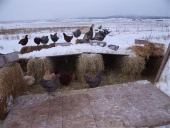
















A proper snow fence will be about 1/2 solid and 1/2 open spaces. This lets most of the snow through the fence but slows the wind, and allows for maximum trapping of snow downwind of the snow fence. The best fencing materials are wood picket and flexible mesh like plastic. To make sure they do the job right without creating more problems, they must be properly placed
A majority of the snow is stored about 20 times the snow fence height downwind of the fence. However, in a severe winter, drift lengths can reach up to 25 to 30 times the fence height. For best results, keep a 4 ft. snow fence back at least 80 ft. and preferably 120 ft. from the road or driveway you want to protect.. You also want it on the predominant up-wind side; so if the road goes from east-to-west, place it on the north side. On a north-south road, put it on the west side.
Fences should be as long as possible extending well beyond the protection zone. A bottom gap of 6 inches left under the fence allows for trapping the maximum amount of snow. Steel posts should be on 8 ft. centers and the end post should be braced with a steel post driven into the ground at an angle so it supports the top of the end post. Plastic fencing material should be sandwiched between two wood laths and wired tightly to the steel post at the center and near the top and bottom.
A longer term solution to drifting snow includes building up roads and driveways so that snow is blown across rather than drifting on to them . By elevating driveways above the surrounding terrain, wind will sweep snow off of the roadway. Also, living snow fences of evergreens and shrubs can be planted to provide a permanent snow fence. Make sure that they are planted well back from the areas they are meant to protect. A good rule of thumb for Iowa is to allow 100-150 ft. for trapping of snow between the living snow fence and area to be protected. Keep grass and weeds alongside roadways mowed down in the fall. This vegetation can act as a mini snow fence creating drifts right on the roadway. Leaving cornstalk stubble undisturbed will trap a great deal of snow out in the field and minimize the amount of snow that can drift onto a roadway.
Anywhere there is an obstruction, snow will drift. By strategically placing or removing these barriers, we can minimize problems from drifting snows.
"You must be the change you want to see in the world." "First they ignore you, then they laugh at you, then they fight you, then you win." --Mahatma Gandhi
"Preach the Gospel always, and if necessary, use words." --Francis of Assisi.
"Family farms work when the whole family works the farm." -- Adam Klaus
 1
1








 1
1




Dale Hodgins wrote:These distances aren't practical for most properties. The distance could probably be shortened if the plantings were tall furthest from the driveway and then shorter bushy stuff were planted in the shelter provided.
Commercial snow fences are designed to create a drift on their leaward side. With plantings, we want the snow to settle within the "fence". A search for information on shelter belts will provide useful ideas. Some places have government programs to promote the use of shelter belts.
In arid regions, those on smaller properties can trap much more than their share of snow with proper use of shelter belts. Open fields can lose much of their snow to neighbouring land that includes trees and bushes.
The increased snow accumulation keeps the soil from freezing deeply and can allow plants to survive that would normally winter kill in that zone. A guy near Montreal, Canada has had pomagranate and persimon survive where conventional wisdom says they should die. The deep snow cover offers protection from -35F cold snaps.

"You must be the change you want to see in the world." "First they ignore you, then they laugh at you, then they fight you, then you win." --Mahatma Gandhi
"Preach the Gospel always, and if necessary, use words." --Francis of Assisi.
"Family farms work when the whole family works the farm." -- Adam Klaus

|
CAUTION! Do not touch the blades on your neck propeller while they are active. Tiny ad:
The new purple deck of permaculture playing cards
https://www.kickstarter.com/projects/paulwheaton/garden-cards
|




